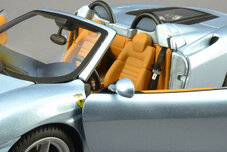2000, 360 Spider (Elite, diecast)
In fact, this was the most technologically advanced spider in the world at the time of its launch thanks to the exclusive transfer of features derived directly from Ferrari’s experiences on the Formula 1 track.
Despite its 400-hp V8 engine’s mid-position (five valves per cylinder), the Ferrari technicians still managed to design a hood that folded away automatically inside the engine bay and guaranteed its superb purity of line. This was further underscored by two fairings in the bodywork to the rear of the seats which evoke memories of Ferrari’s classic sports cars and the roll-bars that guaranteed a safe ride for driver and passenger.
The work done on the chassis focused on delivering maximum static and dynamic rigidity. The sills were reinforced too, the front part of the floor pan was stiffened, and the windshield structure redesigned. The rear bulkhead too was stiffened to dampen engine noise. The 360 Spider’s structural prowess and dynamic response set a whole new chassis-bodywork benchmark for drop-top cars, in fact. The 360 Spider’s lucky occupants were enclosed in a very strong protective crash cage completed by two tubular steel roll bars which were an actually part of the drop-top system. Together with the strengthened windscreen frame, these guaranteed significant protection in case of a roll-over. The 360 Spider had the same suspension as the coupé (double wishbone suspension front and rear) with the same antidive and antisquat geometries. Rolling and pitching were reduced to an absolute minimum and the 360 Spider proved extraordinarily precise entering corners.
The 360 Spider’s running gear was exactly the same as the berlinetta’s: a mid-rear 3586 cc V8 that punched out 400 hp at 8,500 rpm with a longitudinal gearbox in unit with the differential. The result was that both on the track and on the road the 360 Spider delivered almost identical speeds to the Modena. When the top was up or down, it could exceed 290 km/h, in fact. It was barely 60 kg heavier than its berlinetta counterpart but had the same boot space and cabin space.
Retaining the aerodynamic efficiency of the berlinetta was just one of engineers’ goals with the 360 Spider. This was achieved by using twin radiators and an undertray to channel air beneath the car to extractors under its tail. Long hours spent in the wind tunnel also meant that even though it didn’t have a spoiler or wings, it still delivered downforce of over 170 Kg at maximum speed, just 10 less than the berlinetta. This downforce figure was achieved by adding a Formula 1-derived nolder on the leading edge of the tail. The Cd went the berlinetta’s 0.33 to 0.36 in the Spider, well within normal range for a drop-top car.
auto.ferrari.com






























